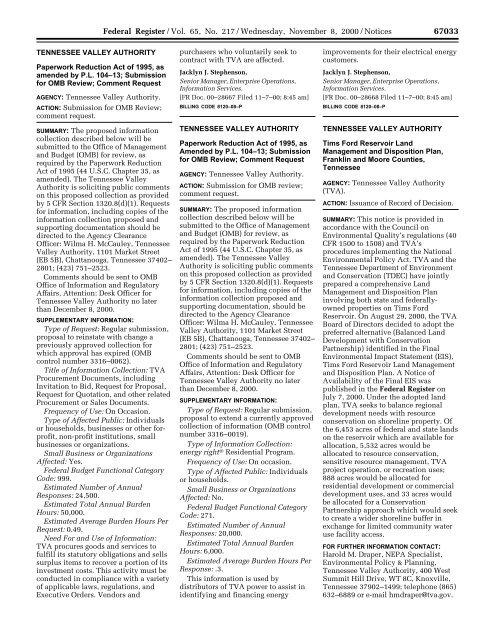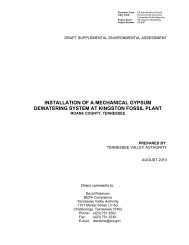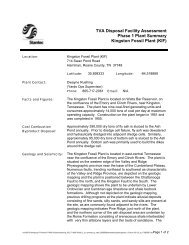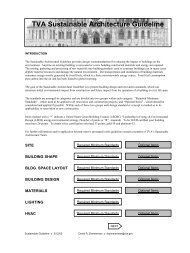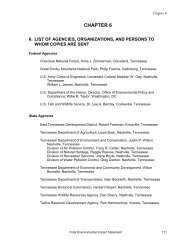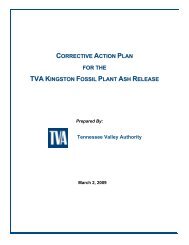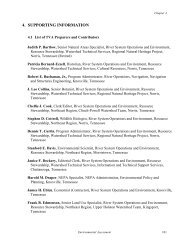65 FR 67033 - Tims Ford Reservoir Land Management - U.S. ...
65 FR 67033 - Tims Ford Reservoir Land Management - U.S. ...
65 FR 67033 - Tims Ford Reservoir Land Management - U.S. ...
- No tags were found...
Create successful ePaper yourself
Turn your PDF publications into a flip-book with our unique Google optimized e-Paper software.
67034 Federal Register / Vol. <strong>65</strong>, No. 217 / Wednesday, November 8, 2000 / NoticesSUPPLEMENTARY INFORMATION: <strong>Tims</strong> <strong>Ford</strong><strong>Reservoir</strong> was completed in 1970 byTVA for the purposes of flood control,hydroelectric generation, recreation, andeconomic development. The reservoir is34 miles long at full pool. There areapproximately 250 miles of shoreline atnormal summer pool (NSP). Followingcompletion of the reservoir, theTennessee Elk River DevelopmentAgency (TERDA), a state agency,developed subdivisions and recreationalfacilities on reservoir propertiesbetween 1970 and 1996. In 1996, theTennessee General Assembly passedPublic Chapter 816, which terminatedTERDA and transferred all powers,duties, contractual obligations,functions and remaining land interestsof the agency to TDEC. TDEC and TVAagreed by contract in 1998 to develop acomprehensive land management anddisposition plan to determine specificuses of reservoir lands. This EIS andland management plan are in fulfillmentof that contract. Originally, 21,863 acresof land were acquired for the <strong>Tims</strong> <strong>Ford</strong>Project. <strong>Reservoir</strong> acreage above NSPwas 11,183. Subsequent transfers andsales of land for various commercial,industrial, residential, and recreationaluses have resulted in a current balanceof 6,453 acres of project lands aboveNSP. These lands are divided inownership between TVA (1,854 acres)and TDEC (4,599 acres).TVA and TDEC announced theirproposal to prepare a <strong>Tims</strong> <strong>Ford</strong> <strong>Land</strong><strong>Management</strong> Plan in October 1998 andheld public scoping meetings onNovember 9, 1998 in Winchester,Tennessee and November 10, 1998 inFayetteville, Tennessee. Writtencomments also were requested throughpublication of a notice in a newspaperand a website. As land allocation andscoping for the land plan developed, itbecame evident that increased levels ofresidential development would resultfrom some of the alternatives.Accordingly, the agencies determinedthat an EIS would allow betterunderstanding of the impacts of thevarious alternatives. On July 22, 1999,TVA issued a Notice of Intent to preparean EIS on alternatives for a landmanagement plan at <strong>Tims</strong> <strong>Ford</strong><strong>Reservoir</strong>. The Notice of Intentindicated that additional comments onthe scope of issues to be addressedcould be submitted in writing orthrough a website. These comments andprevious comments from the 1998scoping period were analyzed todetermine the issues and alternatives tobe considered in the EIS. A Notice ofAvailability for the Draft EIS waspublished in the Federal Register onNovember 12, 1999. TVA and TDECsubsequently held public meetings inWinchester, Tennessee on November 30,1999 and Tullahoma, Tennessee onDecember 2, 1999 to discuss the draftEIS and solicit comments on the draft.Comments were received at publicmeetings and by written responsesthereafter from 268 people, agencies,and organizations. After considering allcomments, the Final EIS was completedand distributed to commenting agenciesand the public. A Notice of Availabilityfor the Final EIS was published on July7, 2000.Alternatives ConsideredTVA initially considered fouralternatives, including no action, forallocation of <strong>Tims</strong> <strong>Ford</strong> lands. Theaction alternatives were characterized as‘‘Balanced <strong>Land</strong> Development andConservation,’’ ‘‘Maximum <strong>Land</strong>Development,’’ and ‘‘Maximum <strong>Land</strong>Conservation.’’The alternatives were designed tovary in the amount of land allocated forresidential development and forresidential shoreline access. In responseto public comments on the Draft EIS,TVA developed a fifth alternative,designated ‘‘Balanced <strong>Land</strong>Development with ConservationPartnership.’’ This alternative wasdesigned to allow increased reservoiraccess while providing additionalshoreline protection.Under Alternative A, the No ActionAlternative, TVA and TDEC would notadopt a jointly prepared plan. In theabsence of a plan, TVA and TDECwould proceed with disposition ormanagement of properties on a case-bycasebasis. Because no joint plan wouldexist, the project lands could beconsidered for a variety of uses. Morethan likely, some amount of shorelineproperty (up to 45 percent of projectlands) could eventually be consideredfor residential or commercial uses.About 22 percent already has beentransferred to the state and localgovernments for recreational usage orare currently being used for recreationalpurposes such as parks and marinas.Those tracts (9 percent of project lands)identified during the planning processas containing rare species, wetlands,cultural resources, or unique naturalfeatures would likely be maintained ina protective category to facilitate TVA’sand TDEC’s compliance with lawsrelating to protection of sensitiveresources. Approximately 20 percent ofproject lands would likely be managedfor natural resource conservationbecause it has been deemed in thecurrent planning process as not suitableor capable for development. Theremaining 4 percent would be retainedfor use as TVA dam reservation (TVAproject operation).Under Alternative B, Balanced <strong>Land</strong>Development and Conservation, parcelstotaling 938 acres would be available forresidential development or residentialaccess, with the rest of project landsallocated to natural resource-orientedand recreational uses. Cumulatively, 25percent of project lands would beallocated to residential uses, 25 percentto recreation uses, and 36 percent tonatural resource-oriented uses. As inAlternative A, approximately 9 percentof project lands would be allocated tosensitive resource management, and 4percent to TVA project operations.Alternative B was identified as theagencies’ preferred alternative in theDraft EIS.Under Alternative B1, Balanced <strong>Land</strong>Development with ConservationPartnership, TVA modified AlternativeB to respond to comments received onthe draft EIS and plan. One parcel of128 acres, which was previouslyallocated to residential development,was changed to a natural resourcemanagement allocation. In addition, anew zone was created, designated‘‘conservation partnership,’’ for certainnarrow shoreline strips of public land.On <strong>Tims</strong> <strong>Ford</strong> <strong>Reservoir</strong>, the agenciesfound numerous locations where thepublic land was narrow and does notprovide sufficient conservation buffer topreserve water quality, conserveshoreline habitat, protect shorelinesfrom long-term erosion, or retainshoreline aesthetics. It has also beenTVA’s experience that due to the closeproximity of private lands to the lake,these narrow public land strips presentunique management problems. Many ofthose who commented on the draft EISstated that because of the closeproximity of their property to thewater’s edge, they had an expectation ofgaining water access under previousmanagement policies. In the new zone,TVA would consider granting wateraccess in the form of limited communitywater use facilities in exchange for awider shoreline buffer zone.Cumulatively, Alternative B1 wouldresult in 24 percent of project landsbeing allocated to residential uses, 25percent to recreation, 37 percent tonatural resource management, 9 percentto sensitive resource management, and 4percent to project operations. Althoughthe acreage difference betweenAlternative B and B1 is small,approximately 9 additional shorelinemiles would be open for considerationof requests for community docks underAlternative B1. Alternative B1 wasVerDate 112000 17:37 Nov 07, 2000 Jkt 194001 PO 00000 Frm 00072 Fmt 4703 Sfmt 4703 E:\<strong>FR</strong>\FM\08NON1.SGM pfrm08 PsN: 08NON1
Federal Register / Vol. <strong>65</strong>, No. 217 / Wednesday, November 8, 2000 / Notices67035identified as the agencies’ preferredalternative in the Final EIS.Under Alternative C, Maximum <strong>Land</strong>Development, all parcels would beallocated for development except thosethat do not meet suitability andcapability criteria, contain sensitiveresources, or are less than 20 acres. Thiswould result in 1,764 more acres ofresidential development than alternativeB1. Cumulatively, residentialdevelopment would encompass 41percent of project lands, recreationaldevelopment 25 percent, naturalresource management 20 percent,sensitive resource management 9percent, and TVA project operations 4percent.Under Alternative D, Maximum <strong>Land</strong>Conservation, no new developmentwould occur outside of existing areas.All undeveloped lands would beconsidered unsuitable for developmentand would be allocated for naturalresource conservation. This wouldresult in 1,087 more acres allocated tonatural resource conservation thanalternative B1. Cumulatively, 17 percentof project lands would be allocated toresidential development, 22 percent torecreation, 48 percent to naturalresource management uses, 9 percent tosensitive resource management, and 4percent to TVA project operations.The EIS considered the environmentalconsequences of the alternatives on awide variety of environmentalresources. Under any alternative,sensitive resources such as endangeredand threatened federal and state-listedspecies, cultural resources, andwetlands would be protected. Adoptionof Alternative B1 would balance thecompeting demands of developmentand conservation. Developmentactivities would cause the potential foradverse environmental impacts.However, through the inclusion ofenvironmental safeguards to addresswater quality, ground water, riparianwildlife habitat, and parcel-specificprotection measures, these impactswould be minimized.During the EIS process, TVA alsoconsulted with the Tennessee StateHistoric Preservation Officer (SHPO),The Eastern Band of Cherokee Indians(EB), the United Keetoowah Band, theCherokee Nation of Oklahoma, theTennessee Commission of IndianAffairs, the Muscogee (Creek) Nation ofOklahoma, and the Poarch Band ofCreek Indians on the identification andevaluation of historic properties withinthe Area of Potential Effect for the <strong>Tims</strong><strong>Ford</strong> <strong>Land</strong> Plan. Following release of theFinal EIS, TVA, TDEC, SHPO, and EBexecuted a Memorandum of Agreementstipulating measures that will be carriedout by TVA and TDEC prior to thecommencement of ground-disturbingactivities. This agreement allows phasedidentification, evaluation, and treatmentof historic properties, and requires thatprior to the transfer of the lands to thirdparties, TVA and TDEC will ensure thata preservation covenant to protecthistoric properties is included. Thesemeasures ensure that the effects of the<strong>Tims</strong> <strong>Ford</strong> <strong>Reservoir</strong> <strong>Land</strong> <strong>Management</strong>and Disposition Plan on historicproperties have been taken into account.Response to Comments on Final EISAppendix B of the Final EIS containssummaries of and responses to thecomments TVA received during theDraft EIS process. TVA receivedcomments from 268 individuals andorganizations. TVA gave the public theopportunity to provide comments on theFinal EIS, which included theConservation Partnership approach.A total of 7 individuals commentedon the Final EIS. Most of thesecomments were from property ownersseeking to clarify whether they hadaccess to the water, or seeking to appealallocation decisions in the final EIS.TVA plans to consider those requeststhat are consistent with the land plan.EPA also commented on the final EIS.Based on their review of the document,they stated that their orderedpreferences for alternatives would be D,B1, B, and C. EPA stated that theywould not oppose B1 as long as alldevelopment is consistent with the TVAShoreline <strong>Management</strong> Initiative EIS/ROD, state water quality and otherregulations as well as federal statutesassociated with delegated programs, andas long as plan implementation ismonitored for environmental impacts.EPA also commented on theenvironmental impacts of residentialdevelopment for water quality,recreation, and TVA’s grandfatheringapproach to existing docks. TVA agreesthat residential development wouldneed to be carefully monitored forcompliance with existing regulations toavoid adverse water and air qualityimpacts.DecisionThe TVA Board decided to adopt the<strong>Tims</strong> <strong>Ford</strong> <strong>Land</strong> <strong>Management</strong> andDisposition Plan as described inAlternative B1 on August 29, 2000. TheTennessee State Building Commissiondecided to adopt the plan as describedin Alternative B1 on September 14,2000. TVA believes that Alternative B1appropriately balances residentialshoreline development, recreation use,and resource conservation needs in away that maintains the quality of lifeand other important values associatedwith <strong>Tims</strong> <strong>Ford</strong> <strong>Reservoir</strong>. It recognizesthe reality that previous decisions havealready allowed residentialdevelopment on portions of theshoreline, and previous managementhas created ‘‘expectations’’ for wateraccess among those with shorelineproperty. It uses logical criteria fordetermining which stretches ofshoreline could have water access,based on past decisions made by theagencies or on distance between theprivate property line and NSP. Itprovides a new zone involvingpartnerships for conservation thatwould result in the creation of widershoreline buffers and more protectionfor water quality and riparian habitats.Finally, it makes an allocation changethat would result in additional lands atthe lower end of the reservoir beingdedicated to natural resourceconservation.Like the other alternatives considered,Alternative B1 sets aside parcelscontaining sensitive resources andhabitats in the Sensitive ResourceProtection and Natural ResourceConservation categories. Even for landsthat were considered suitable for andcapable of development, Alternative B1adopts commitments that would furtherminimize the potential for adverseimpacts to the environment. Thesecommitments are listed below, underEnvironmental Commitments.Environmentally Preferable AlternativeTVA has concluded that AlternativeD, which would allow no new landdevelopment outside of existing areas, isthe environmentally preferablealternative. However, the authorizinglegislation for <strong>Tims</strong> <strong>Ford</strong> <strong>Reservoir</strong>, thestate legislation transferring lands toTDEC, and the local governmentsencourage the use of portions of thereservoir lands to foster the economicdevelopment of the area. TVA believesthat Alternative B1 helps to meet themultiple objectives of the <strong>Tims</strong> <strong>Ford</strong>project, and would result insubstantially better environmentalprotection than previous shorelinedevelopment practices.Environmental CommitmentsThe land plan envisioned inAlternative B1 advances TVA’scommitment to resource stewardshipand habitat protection through strongconservation approaches, including anew conservation partnership zone toincrease shoreline buffers from aminimum of 50 feet to a maximum of100 feet. Alternative B1 was formulatedusing environmentally protectivemeasures. Some of these measuresVerDate 112000 17:37 Nov 07, 2000 Jkt 194001 PO 00000 Frm 00073 Fmt 4703 Sfmt 4703 E:\<strong>FR</strong>\FM\08NON1.SGM pfrm08 PsN: 08NON1
67036 Federal Register / Vol. <strong>65</strong>, No. 217 / Wednesday, November 8, 2000 / Noticesinclude use of a sensitive resourceprotection zone and retention of apublic shoreline strip between the 888and 895 foot contours. New proposalsfor access would be allowed usingcommunity docks rather than throughindividual docks, thus minimizing thearea of shoreline that will be disturbed.For certain categories of accessproposals, TVA would obtain additionalshoreline buffers above the 895-footcontour. In addition, TVA is adoptingthe following measures to minimizeenvironmental impacts:• New residential development willbe required to have groundwaterprotection plans submitted by thedeveloper for approval prior todevelopment.• Throughout the construction phaseof new subdivisions, periodic sitechecks will be conducted to ensure thatBMPs are used to minimize erosionproblems.• Shoreline fringe wetlands will beavoided during any future developmentor permitting activities.• Parcels containing uncommonterrestrial habitats or plants will beprotected by avoidance during anyfuture developmental activities. Saledeeds related to disposition will includeconditions that require avoidance of theresource on the parcel.• Livestock grazing on TVA propertywill be phased out as alternative watersources and pasture are obtained.• The measures relating toidentification, evaluation, and treatmentof historic properties contained in theMemorandum of Agreement betweenTVA, Tennessee State HistoricPreservation Officer, TennesseeDepartment of Environment andConservation, and the Eastern Band ofCherokee Indians, dated September 21,2000, will be followed.With the implementation of the aboveenvironmental protection measures,TVA has determined that adverseenvironmental impacts of futureresidential shoreline uses would besubstantially reduced. These protectivemeasures represent all of the practicablemeasures to avoid or minimizeenvironmental harm that are associatedwith this alternative.As TVA and TDEC implement the<strong>Tims</strong> <strong>Ford</strong> <strong>Land</strong> <strong>Management</strong> andDisposition Plan, the agencies willcontinue to work with all affectedinterests to promote environmentallysound stewardship of public lands.Dated: October 26, 2000.Kathryn J. Jackson,Executive Vice President, River SystemOperations & Environment.[<strong>FR</strong> Doc. 00–28670 Filed 11–7–00; 8:45 am]BILLING CODE 8120–08–PDEPARTMENT OF THE TREASURYFiscal ServiceSurety Companies Acceptable onFederal Bonds—Termination: EmpireFire and Marine Insurance CompanyAGENCY: Financial <strong>Management</strong> Service,Fiscal Service, Department of theTreasury.ACTION: Notice.SUMMARY: This is Supplement No. 4 tothe Treasury Department Circular 570;2000 Revision, published June 30, 2000,at <strong>65</strong> <strong>FR</strong> 40868.FOR FURTHER INFORMATION CONTACT:Surety Bond Branch at (202) 874–6696.SUPPLEMENTARY INFORMATION: Notice ishereby given that the Certificate ofAuthority issued by the Treasury to theabove named Company, under theUnited States Code, Title 31, Sections9304–9308, to qualify as an acceptablesurety on Federal bonds is terminatedeffective immediately.The Company was last listed as anacceptable surety on Federal bonds at <strong>65</strong><strong>FR</strong> 40879, June 30, 2000.With respect to any bonds currentlyin force with above listed Company,bond-approving officers may let suchbonds run to expiration and need notsecure new bonds. However, no newbonds should be accepted from theCompany. In addition, bonds that arecontinuous in nature should not berenewed.The Circular may be viewed anddownloaded through the Internet athttp://www.fms.tres.gov/c570/index.html. A hard copy may bepurchased from the GovernmentPrinting Office (GPO), SubscriptionService, Washington, DC, telephone(202) 512–1800. When ordering theCircular from GPO, use the followingstock number: 048–000–00536–5.Questions concerning this notice maybe directed to the U.S. Department ofthe Treasury, Financial <strong>Management</strong>Service, Financial Accounting andServices Division, Surety Bond Branch,3700 East-West Highway, Room 6A04,Hyattsville, MD 20782.Dated: October 30, 2000.Wanda J. Rogers,Director, Financial Accounting and ServicesDivision, Financial <strong>Management</strong> Service.[<strong>FR</strong> Doc. 00–28588 Filed 11–7–00; 8:45 am]BILLING CODE 4810–35–MVerDate 112000 17:45 Nov 07, 2000 Jkt 194001 PO 00000 Frm 00074 Fmt 4703 Sfmt 4703 E:\<strong>FR</strong>\FM\08NON1.SGM pfrm08 PsN: 08NON1


